An Integrated Control Approach for Shifting Process of Single-Axis Parallel Hybrid Electric Vehicle with a Multi-Speed AMT Gearbox
Abstract
1. Introduction
- (1)
- The data-driven model predictive control method is designed to combine system input and output data, enhancing anti-interference capability during the torque unloading and recovery phases;
- (2)
- Additionally, a P control and disturbance observer are employed to achieve reference speed tracking in the speed synchronization phase, even in the presence of external interference;
- (3)
- Furthermore, a new sliding mode active disturbance rejection control method is applied to improve the tracking accuracy and robustness of the sleeve displacement during the pickup and engage phase.
- (1)
- The development of a comprehensive driveline model, with special attention to the shift actuator, to enhance the accuracy of describing shifting problems.
- (2)
- In consideration of external disturbances and uncertainties in model parameters, a novel multistage control architecture integrating robust control methods is devised for each shifting stage. This architecture enables coordinated control of different power sources and clutches while reducing jerk in various driving conditions.
- (3)
- Simulation and bench tests are conducted to validate the effectiveness of the control method under different driving conditions. Various experimental results indicate that the proposed integrated robust control method effectively enhances vehicle adaptability across multiple working conditions and in the face of external interference at each shift stage. This research holds significant reference value for improving shifting robustness in similar vehicles.
2. Models and Problem Formulation
2.1. Driveline Modelling
2.2. AMT Actuating Mechanism Model
2.3. Control Problem Formulation
- (1)
- During the torque unloading and recovery phase, it is necessary to coordinate and control the engine torque, motor MG1 torque, and clutch torque to prevent significant vehicle jerk.
- (2)
- During the speed synchronization phase, the AMT is in neutral and the connection between the EM and the transmission system is cut off. The control objective is to design efficient speed control algorithms to improve the speed accuracy of the EM and shorten the speed synchronization time.
- (3)
- During the pickup and engage phase, the shift actuator mainly functions, and the control core is to quickly track the target displacement of the sleeve to reduce tracking error of displacement. Therefore, it is necessary to adjust the shift force generated by the shift actuator to achieve closed-loop control of the sleeve displacement.
3. Methods and Materials
3.1. Data-Driven Model Predictive Control in Torque Unload and Recovery Phase
3.2. P control and Disturbance Observer in Speed Synchronization Phase
3.3. Sliding Mode Active Disturbance Rejection Control in Pickup and Engage Phase
- (1)
- Encode the initial population of key parameters , , , and .
- (2)
- Evaluate the individual fitness value in the population, and set the objective function as the fitness function. To obtain a good observation effect, this paper selects the integral of time weighted absolute value of the error as the fitness function:where is the error between the estimated value and the actual value.
- (3)
- Select the best individual from the initial population for crossover and mutation operations to determine whether the iteration termination conditions are met. If satisfied, the optimal parameters are output. If not, continue to select regenerated individuals and perform crossover and mutation operations with a certain probability to generate a new generation of population, and return to step (2).
4. Results and Discussion
4.1. Basic Settings
4.2. Simulation Results and Discussion
- (1)
- How to develop an effective collaborative control mechanism for multi power source that enables active compensation optimization that considers both smoothness and economy.
- (2)
- In real-world vehicle operations, factors such as various working conditions (starting, accelerating, climbing, etc.) and interference effects (model uncertainties) can negatively impact vehicle control performance.
4.3. Test Results and Discussion
5. Conclusions
Author Contributions
Funding
Data Availability Statement
Conflicts of Interest
Appendix A
Appendix B
Appendix C
Appendix D
References
- Du, G.; Zou, Y.; Zhang, X.; Guo, L.; Guo, N. Energy management for a hybrid electric vehicle based on prioritized deep reinforcement learning framework. Energy 2022, 241, 122523. [Google Scholar] [CrossRef]
- Zhou, J.; Xue, Y.; Xu, D.; Li, C.; Zhao, W. Self-learning energy management strategy for hybrid electric vehicle via curiosity-inspired asynchronous deep reinforcement learning. Energy 2022, 242, 122548. [Google Scholar] [CrossRef]
- Hu, J.; Liu, D.; Du, C.; Yan, F.; Lv, C. Intelligent energy management strategy of hybrid energy storage system for electric vehicle based on driving pattern recognition. Energy 2020, 198, 117298. [Google Scholar] [CrossRef]
- Li, W.; Kang, C.; Zhu, X. Coordinated speed and position control of integrated motor-transmission system. Trans. Inst. Meas. Control 2021, 43, 3013–3023. [Google Scholar] [CrossRef]
- Wang, F.; Xia, J.; Xu, X.; Cai, Y.; Zhou, Z.; Sun, X. New clutch oil-pressure establishing method design of PHEVs during mode transition process for transient torsional vibration suppression of planetary power-split system. Mech. Mach. Theory 2020, 148, 103801. [Google Scholar] [CrossRef]
- Lin, C.; Sun, S.; Jiang, W. Active anti-jerking control of shifting for electric vehicle driveline. Energy Procedia 2016, 104, 348–353. [Google Scholar] [CrossRef]
- Wang, Y.; Wu, J.; Zhang, N.; Mo, W. Dynamics modeling and shift control of a novel spring-based synchronizer for electric vehicles. Mech. Mach. Theory 2022, 168, 104586. [Google Scholar] [CrossRef]
- Cheng, K.; Qin, D.; Jian, J.; Wu, B. Adaptive gearshift control of wet dual clutch transmission based on extended state observer and H infinity robust control. Proc. Inst. Mech. Eng. Part C J. Mech. Eng. Sci. 2021, 235, 6586–6598. [Google Scholar] [CrossRef]
- Li, G.; Grges, D. Optimal control of the gear shifting process for shift smoothness in dual-clutch transmissions. Mech. Syst. Signal Process. 2018, 103, 23–38. [Google Scholar] [CrossRef]
- Zhao, Z.; Jiading, G.; Lu, H. Estimation of torques transited by twin-clutch during shifting process for dry dual clutch transmission. J. Mech. Eng. 2017, 53, 77–87. [Google Scholar] [CrossRef]
- Liu, T.; Zeng, X.; Song, D. MPC-Based coordinated control of gear shifting process for a power split hybrid electric bus with a clutchless AMT. Chin. J. Mech. Eng. 2022, 35, 144. [Google Scholar] [CrossRef]
- Tseng, C.Y.; Yu, C.H. Advanced shifting control of synchronizer mechanisms for clutchless automatic manual transmission in an electric vehicle. Mech. Mach. Theory 2015, 84, 37–56. [Google Scholar] [CrossRef]
- Zhong, Z.; Kong, G.; Yu, Z.; Xin, X.; Chen, X. Shifting control of an automated mechanical transmission without using the clutch. Int. J. Automot. Technol. 2012, 13, 487–496. [Google Scholar] [CrossRef]
- Qin, D.T.; Yao, M.Y.; Chen, S.J.; Lyu, S.K. Shifting process control for two-speed automated mechanical transmission of pure electric vehicles. Int. J. Precis. Eng. Manuf. 2016, 17, 623–629. [Google Scholar] [CrossRef]
- Wang, D.; Liu, G.; Jin, Y.; Wang, M.; Zhu, Y. Gear-shifting control of clutchless automated mechanical transmission without synchronizer in short-distance pure electric vehicle. China J. Highw. Transp. 2017, 30, 144–152. [Google Scholar]
- Sun, D.; Qin, D. Clutch starting control with a constant engine speed in part process for a car. J. Mech. Eng. 2003, 39, 108–112. [Google Scholar] [CrossRef]
- Xia, G.; Chen, J.; Tang, X.; Zhao, L.; Sun, B. Shift quality optimization control of power shift transmission based on particle swarm optimization—Genetic algorithm. Proc. Inst. Mech. Eng. Part D J. Automob. Eng. 2022, 236, 872–892. [Google Scholar] [CrossRef]
- Li, J.; Wei, H.; Sun, F.; Zhang, C. Coordinated control of downshift powertrain of combined clutch transmissions for electric vehicles. Energy Procedia 2014, 61, 1917–1920. [Google Scholar] [CrossRef][Green Version]
- Zhang, L.; Yang, L.; Guo, X.; Yuan, X. Stage-by-phase multivariable combination control for centralized and distributed drive modes switching of electric vehicles. Mech. Mach. Theory 2020, 147, 103752. [Google Scholar] [CrossRef]
- Wang, X.; Li, L.; He, K.; Liu, C. Dual-loop self-learning fuzzy control for AMT gear engagement: Design and experiment. IEEE Trans. Fuzzy Syst. 2018, 26, 1813–1822. [Google Scholar] [CrossRef]
- Nguyen, C.; Walker, P.; Zhang, N. Optimization and coordinated control of gear shift and mode transition for a dual-motor electric vehicle. Mech. Syst. Signal Process. 2021, 158, 107731. [Google Scholar] [CrossRef]
- Lu, Z.; Tian, G.; Onori, S. Time-Optimal Coordination Control for the Gear-Shifting Process in Electric-Driven Mechanical Transmission (Dog Clutch) without Impacts. SAE Int. J. Elec. Veh. 2020, 9, 155–168. [Google Scholar] [CrossRef]
- Alt, B.; Antritter, F.; Svaricek, F.; Blath, J.P.; Schultalbers, M. Improved performance for the synchronization of the angular velocity in hybrid electric vehicles using a feedforward strategy. IFAC Proc. Vol. 2010, 43, 530–535. [Google Scholar] [CrossRef]
- Gasper, R.; Abel, D. Flatness based control of a parallel hybrid drivetrain. IFAC Proc. Vol. 2010, 43, 524–529. [Google Scholar] [CrossRef]
- Gu, Y.; Yin, C.; Zhang, J. Optimal torque control strategy for parallel hybrid electric vehicle with automatic mechanical transmission. Chin. J. Mech. Eng. 2007, 20, 16–20. [Google Scholar] [CrossRef]
- Montazeri-Gh, M.; Asadi, M. Optimisation of AMT gear shifting strategy in hybrid electric vehicles. Int. J. Veh. Auton. Syst. 2009, 7, 1–17. [Google Scholar]
- ul Amin, R.; Aijun, L.; Khan, M.U.; Shamshirband, S.; Kamsin, A. An adaptive trajectory tracking control of four rotor hover vehicle using extended normalized radial basis function network. Mech. Syst. Signal Process. 2017, 83, 53–74. [Google Scholar] [CrossRef]
- Kahlbau, S.; Bestle, D. Optimal shift control for automatic transmission. Mech. Based Des. Struct. Mach. 2013, 41, 259–273. [Google Scholar] [CrossRef]
- Garofalo, F.; Glielmo, L.; Iannelli, L.; Vasca, F. Optimal tracking for automotive dry clutch engagement. In Proceedings of the 15th IFAC Triennial World Congress, Barcelona, Spain, 21–26 July 2002. [Google Scholar]
- David, J.; Natarajan, N. Plant Identification and Design of Optimal Clutch Engagement Controller; SAE Technical Paper 2006-01-3539; SAE International: Warrendale, PA, USA, 2006; Available online: https://www.sae.org/publications/technical-papers/content/2006-01-3539/ (accessed on 2 August 2022).
- Jin, T.; Li, P.; Zhu, G. Optimal decoupled control for dry clutch engagement. In Proceedings of the IEEE American Control Conference, Washington, DC, USA, 17–19 June 2013; pp. 6740–6745. [Google Scholar]
- Zeng, X.; Yang, N.; Wang, J.; Song, D.; Zhang, N.; Shang, M.; Liu, J. Predictive-model-based dynamic coordination control strategy for power-split hybrid electric bus. Mech. Syst. Signal Process. 2015, 60, 785–798. [Google Scholar] [CrossRef]
- Wu, M. Hamilton Jacobi Inequality based sliding mode robust control for optimal torque transmissions of dry dual clutch assembly in torque phase of shift. In Proceedings of the 2017 IEEE International Conference on Mechatronics and Automation (ICMA), Takamatsu, Japan, 6–9 August 2017; pp. 1900–1905. [Google Scholar]
- Hu, Y.; Tian, L.; Gao, B.; Chen, H. Nonlinear gearshifts control of dual-clutch transmissions during inertia phase. ISA Trans. 2014, 53, 1320–1331. [Google Scholar] [CrossRef]
- Shen, Y.; Wu, G.; Luo, X. Precise tracking control of AMT electric shift actuator. Automob. Technol. 2014, 1, 24–28. [Google Scholar]
- Laukenmann, M.; Sawodny, O. Model-based control of a clutch actuator used in hybrid dual-clutch transmissions. Mechatronics 2021, 77, 102585. [Google Scholar] [CrossRef]
- Zhang, L.; Yang, H.; Peng, Y.; Li, S. A novel synchronizer for clutchless automated manual transmissions applied in electric vehicles. Mech. Mach. Theory 2022, 170, 104688. [Google Scholar] [CrossRef]
- Akbari, M.S.; Asemani, M.H.; Vafamand, N.; Mobayen, S.; Fekih, A. Observer-based predictive control of nonlinear clutchless automated manual transmission for pure electric vehicles: An LPV approach. IEEE Access 2021, 99, 3054370. [Google Scholar] [CrossRef]
- Zhao, J.; Wang, J. Integrated model predictive control of hybrid electric vehicle coupled with aftertreatment systems. IEEE Trans. Veh. Technol. 2016, 65, 1199–1211. [Google Scholar] [CrossRef]
- Zhou, X.; Qin, D.; Hu, J. Multi-objective optimization design and performance evaluation for plug-in hybrid electric vehicle powertrains. Appl. Energy 2017, 208, 1608–1625. [Google Scholar] [CrossRef]
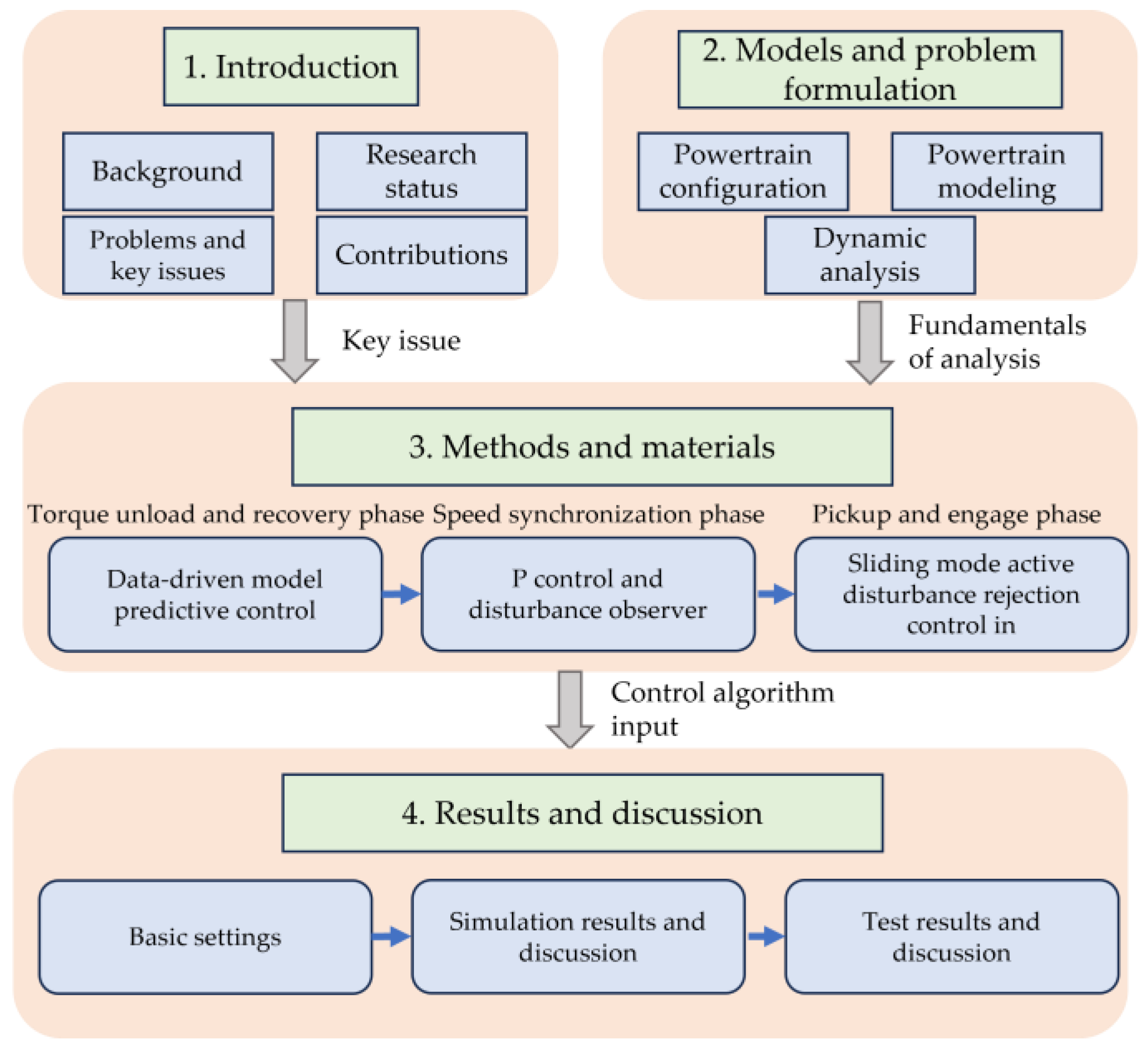
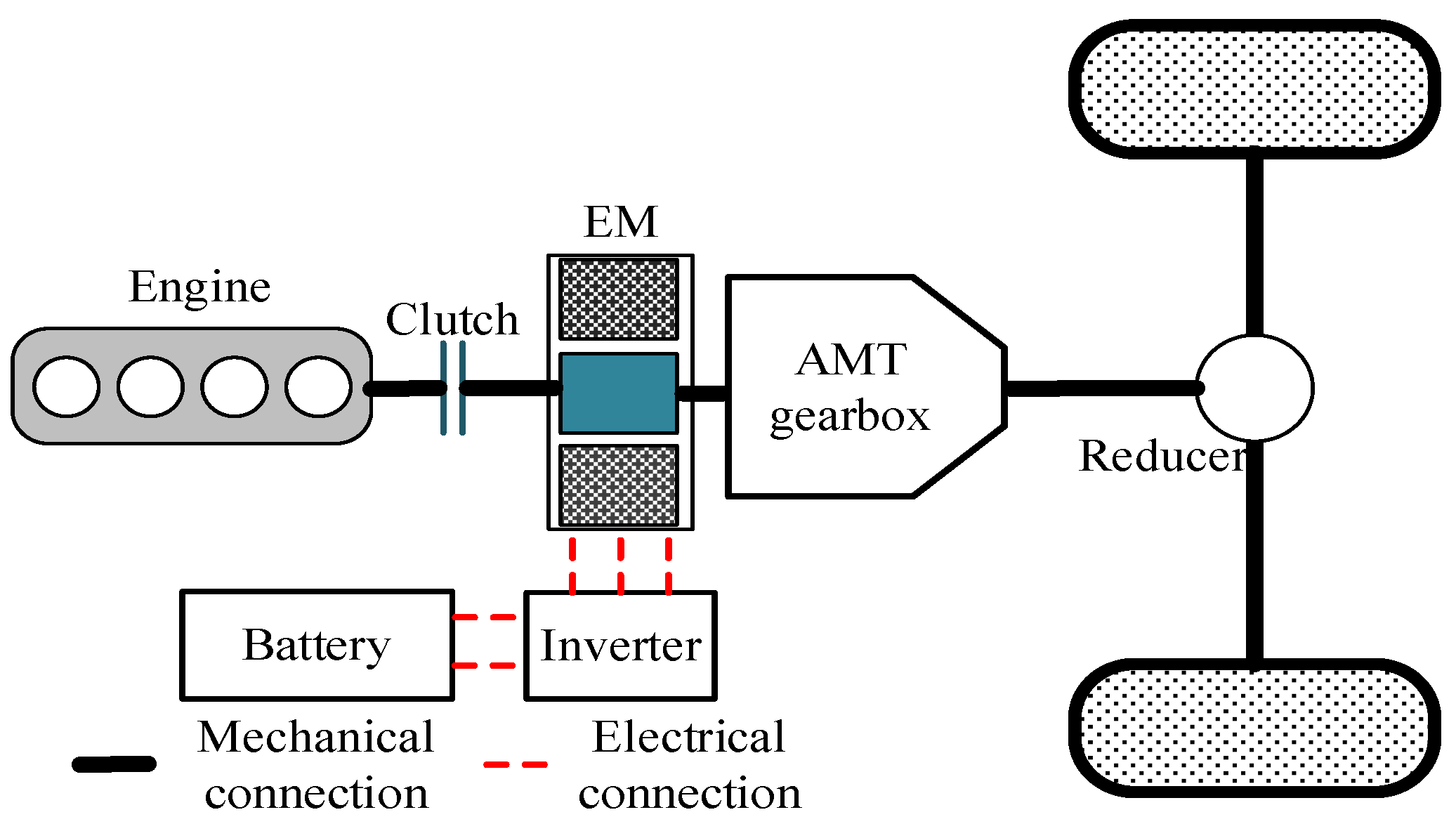


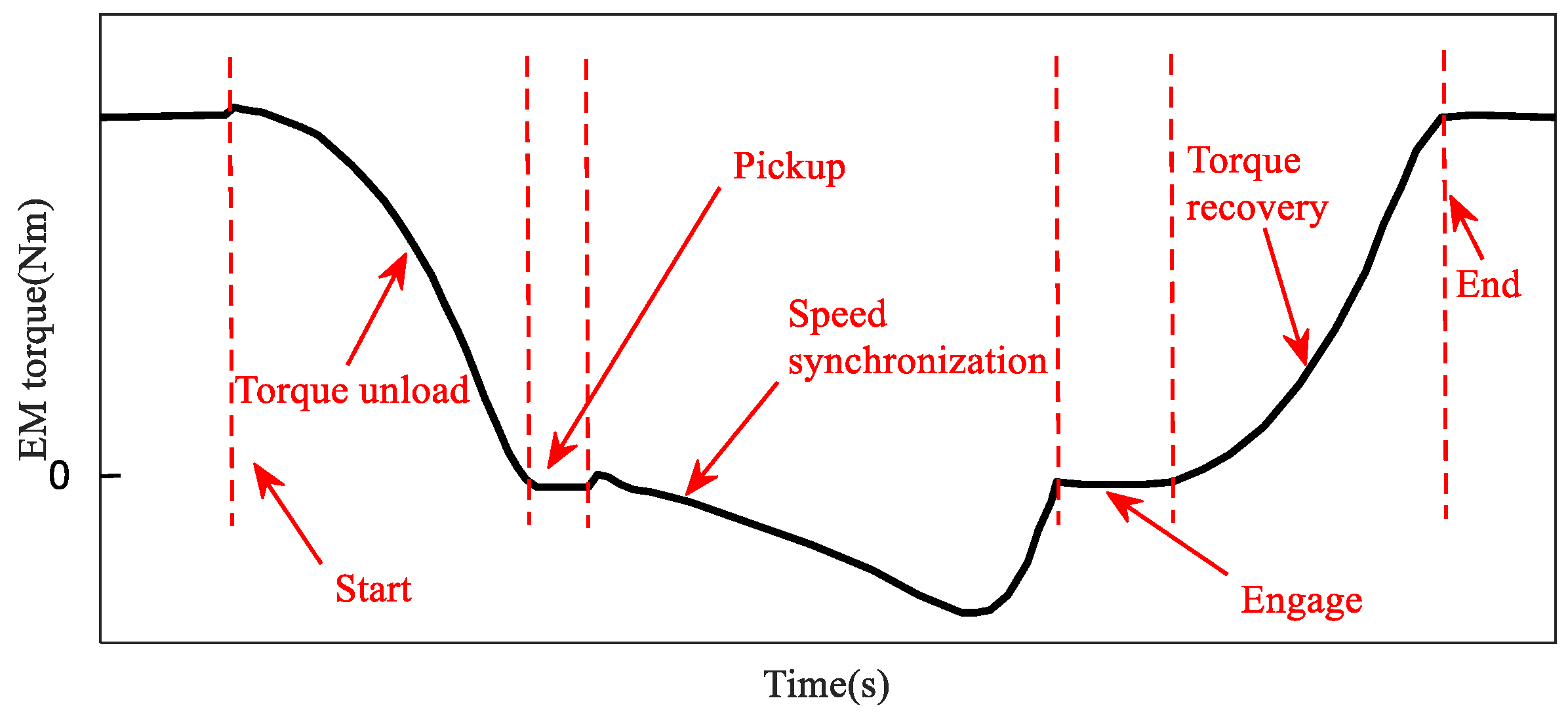
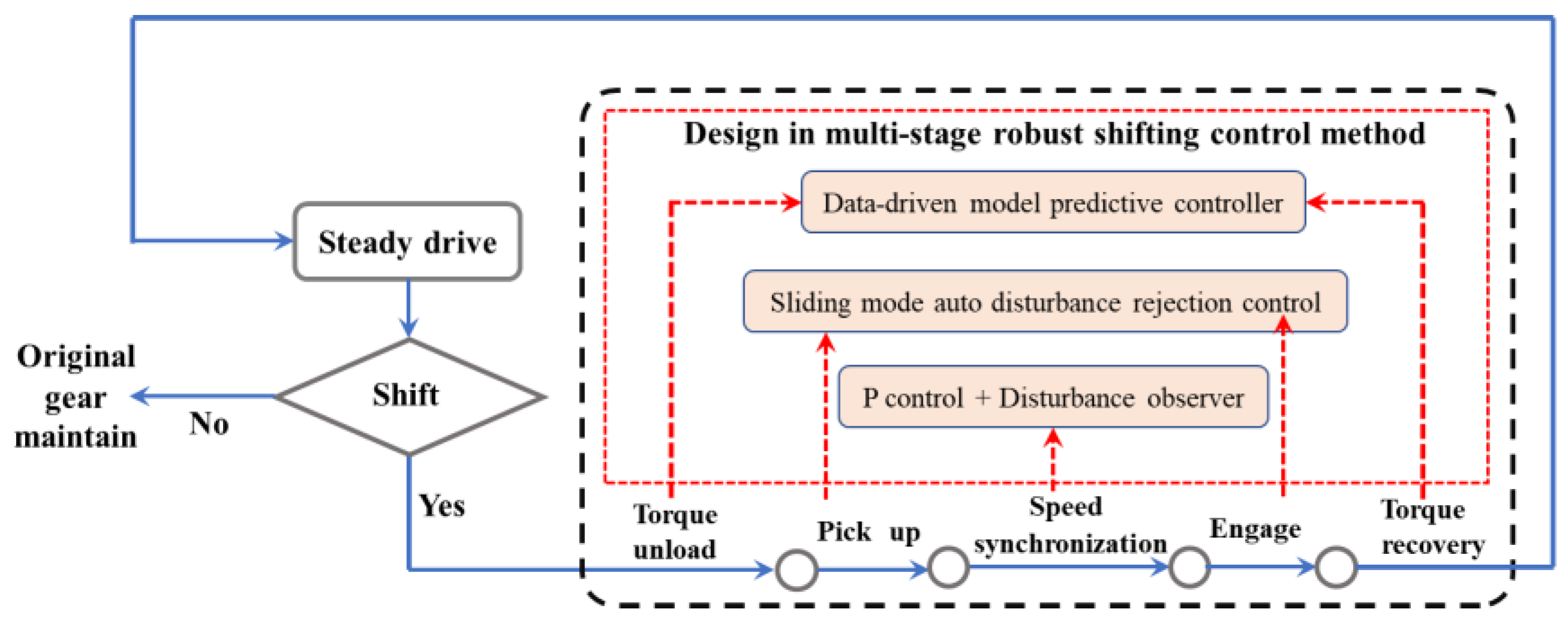

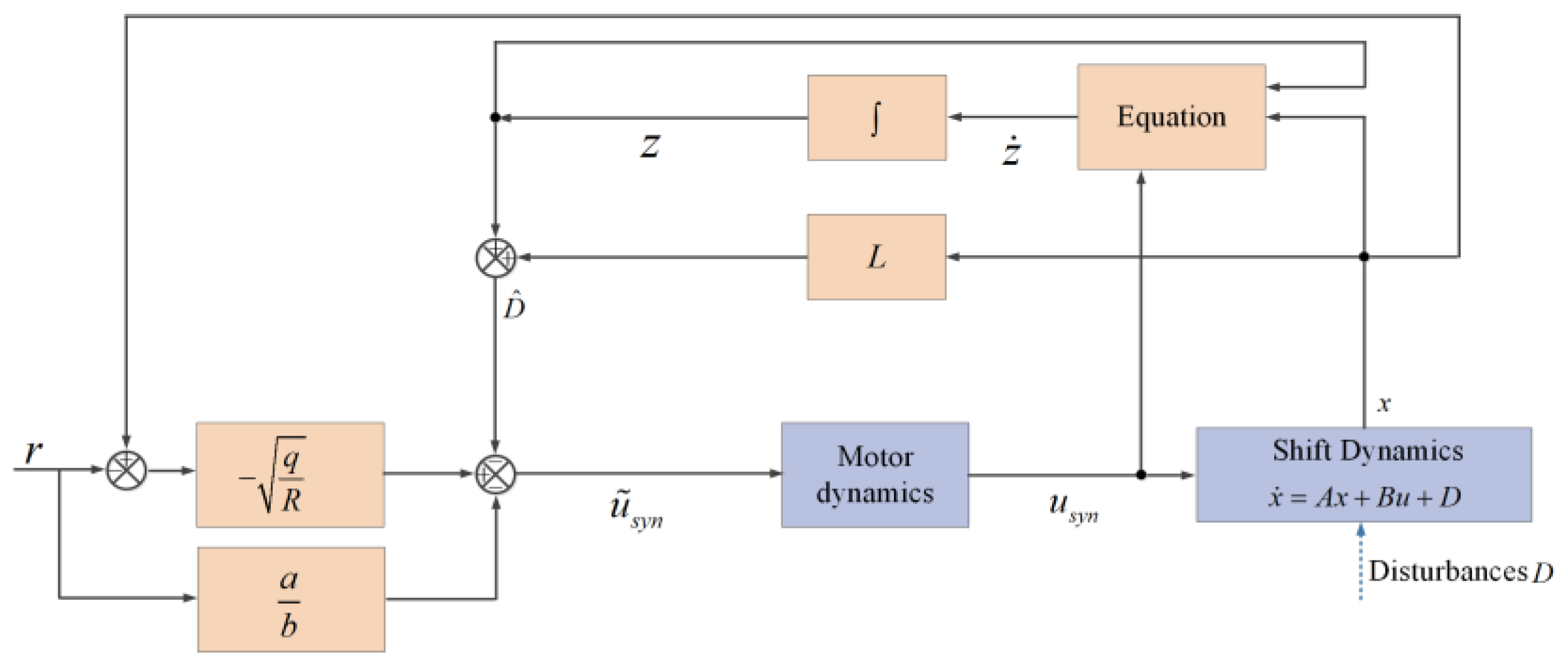
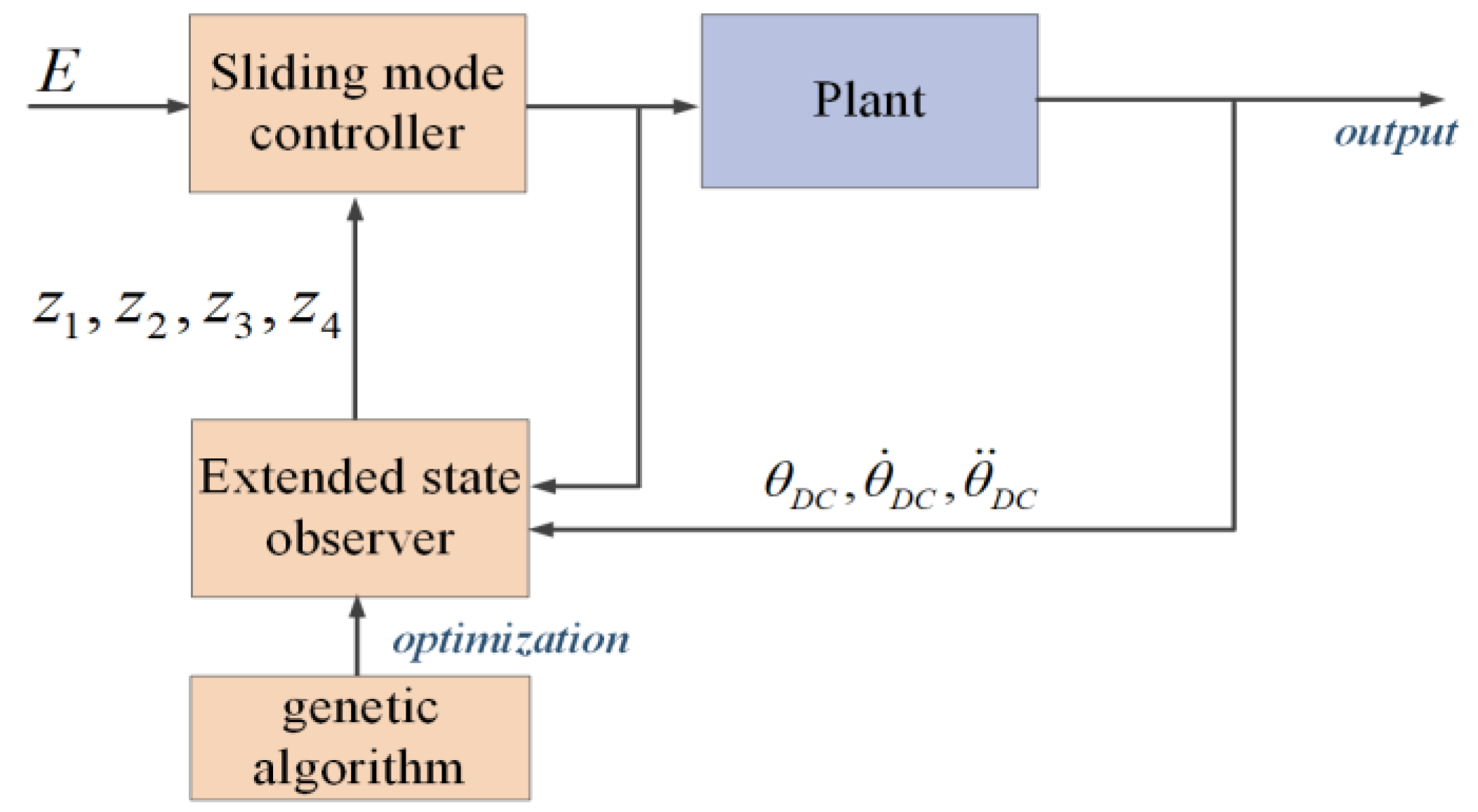
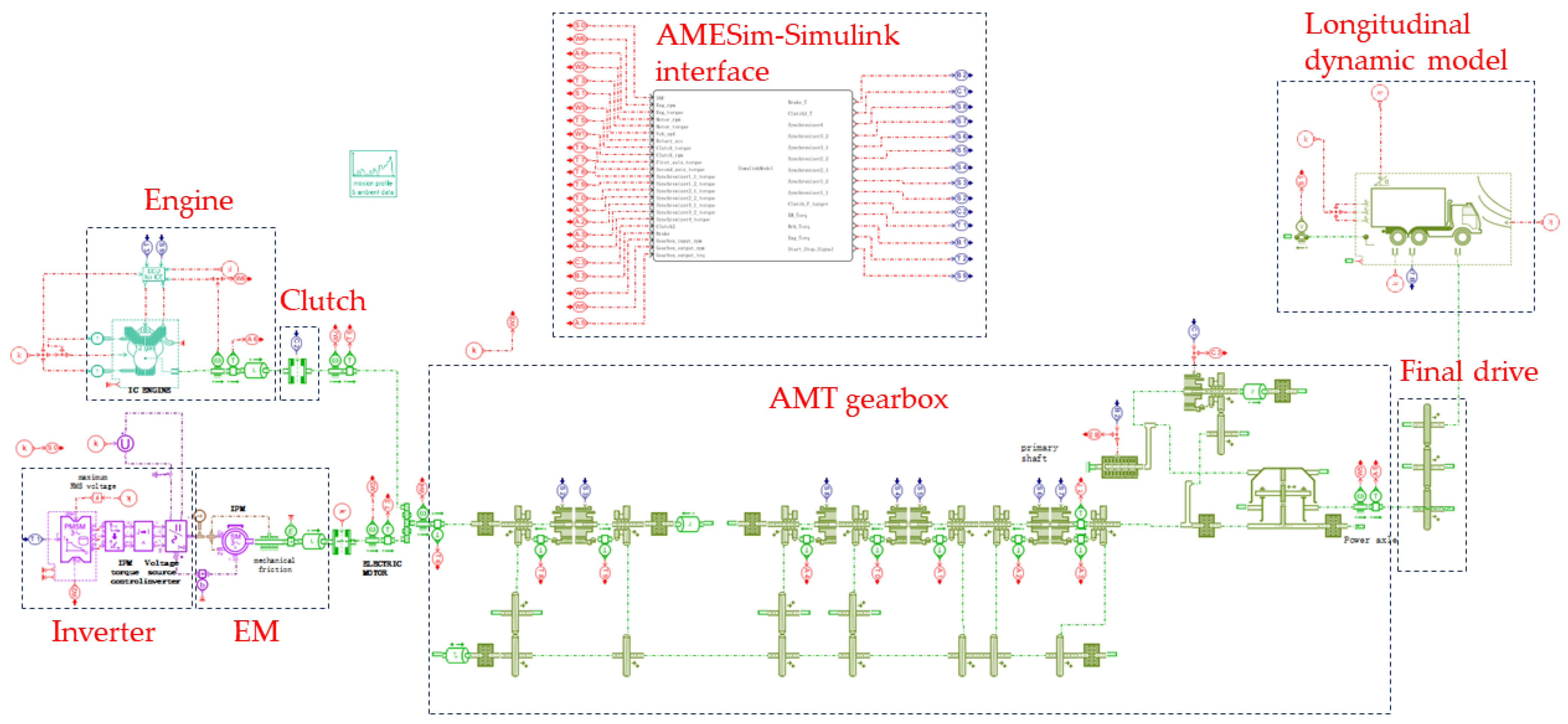
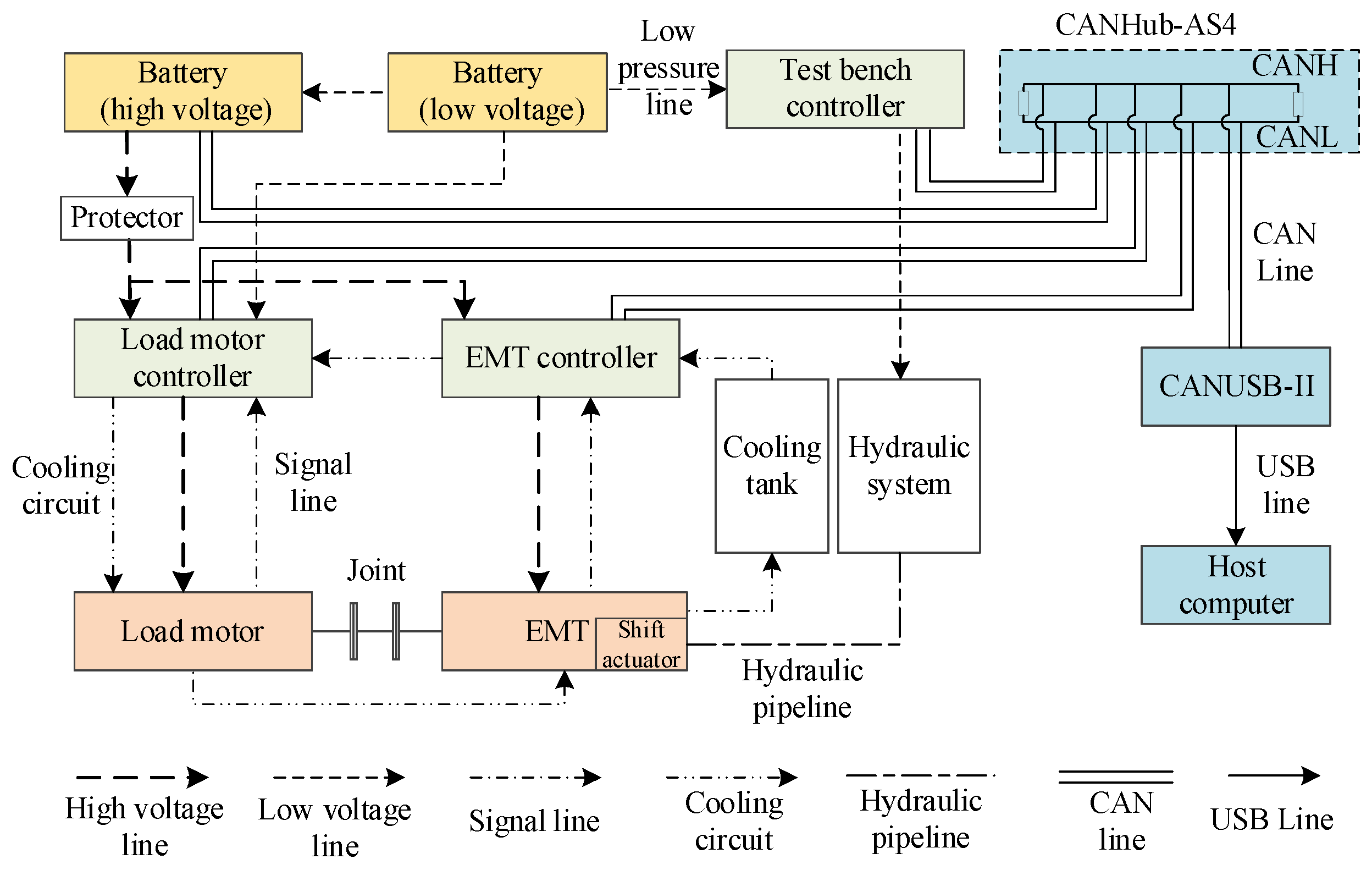
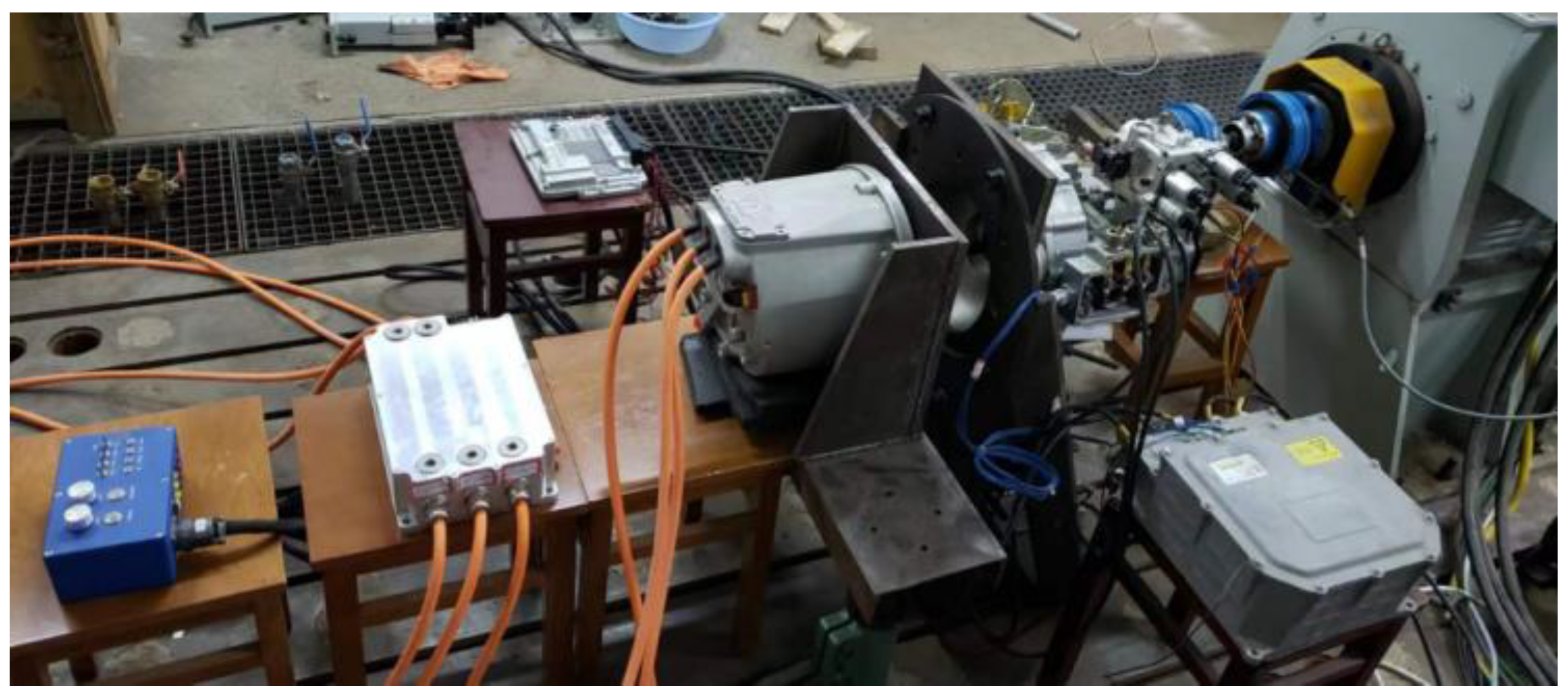

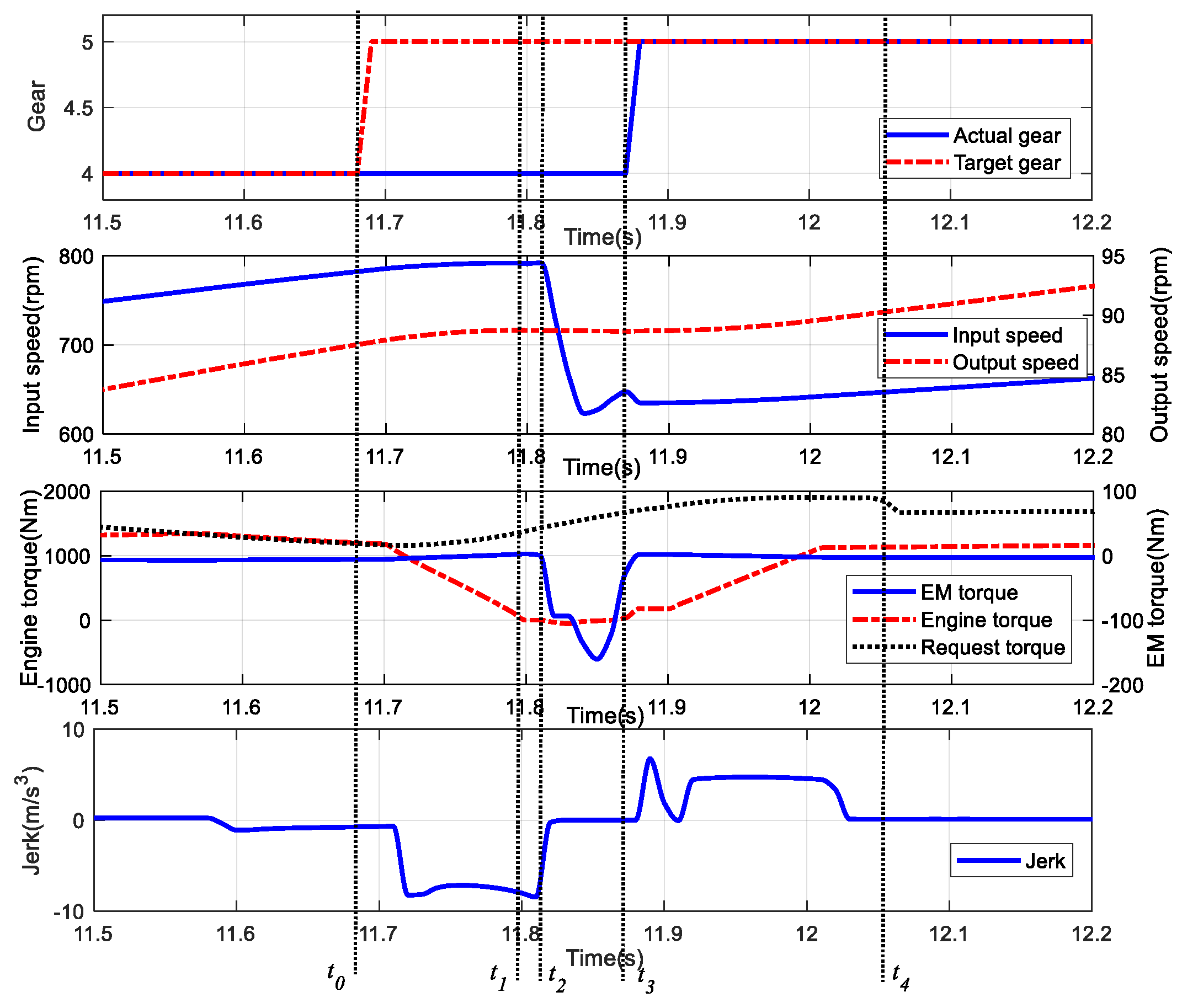




| Item | Definition | Descriptions |
|---|---|---|
| Phase1 | Torque unload | Clear the torque of the EM |
| Phase2 | Pickup | Control the voltage of shifting motor to adjust the shifting force, and separate the sleeve and gear ring in the meshing state |
| Phase3 | Speed synchronization | Motor controller controls the EM for speed regulation |
| Phase4 | Engage | The shift actuator pushes the sleeve to move axially and enter the target gear position |
| Phase5 | Torque recovery | Restore power according to the shift control strategy until the vehicle returns to normal driving mode |
| Parameter | Value | Parameter | Value |
|---|---|---|---|
| 1.52 kg m2 | 6.5 m2 | ||
| 0.047 kg m2 | 1.2258 kg/m3 | ||
| 0.071 m | 0.528 m | ||
| 0.035 m | 2.87 | ||
| 6 | 0.33 Ω | ||
| 0.095 | 0.022 H | ||
| 0.37 kg m2 | 0.04 Vs/rad | ||
| 25,000 kg | 0.02 Nm/A | ||
| 9.8 m/s2 | 0.002 kg m2 | ||
| 0.004 | 0.0054 Nm/rad | ||
| 0.5 | 0.005 m |
| Item | No Active Control | PID Control | IMSR Control |
|---|---|---|---|
| (ms) | 120 | 70 | 60 |
| (ms) | 100 | 100 | 60 |
| (ms) | 140 | 60 | 50 |
| (ms) | 370 | 330 | 170 |
| Total shift time (ms) | 730 | 560 | 340 |
| Maximum jerk (m/s3) | −19.83 | −15.36 | −7.58 |
| Item | Gear1 to 2 | Gear2 to 3 | Gear3 to 4 | Gear4 to 5 | Gear5 to 6 | Gear6 to 7 | Gear7 to 8 |
|---|---|---|---|---|---|---|---|
| (ms) | 100 | 115 | 102 | 120 | 105 | 115 | 110 |
| (ms) | 107 | 115 | 115 | 112 | 106 | 115 | 112 |
| (ms) | 155 | 160 | 137 | 165 | 178 | 165 | 158 |
| (ms) | 342 | 352 | 335 | 350 | 330 | 342 | 335 |
| Total shift time (ms) | 704 | 742 | 689 | 747 | 719 | 737 | 715 |
| Maximum jerk (m/s3) | 17.50 | 8.48 | 19.82 | 15.35 | 11.56 | 14.27 | 16.62 |
| Friction work (J) | 9453.20 | 9885.36 | 8999.76 | 8750.96 | 9940.74 | 8867.32 | 9263.12 |
| Item | Gear1 to 2 | Gear2 to 3 | Gear3 to 4 | Gear4 to 5 | Gear5 to 6 | Gear6 to 7 | Gear7 to 8 |
|---|---|---|---|---|---|---|---|
| (ms) | 102 | 115 | 100 | 112 | 102 | 115 | 102 |
| (ms) | 65 | 62 | 60 | 60 | 58 | 60 | 70 |
| (ms) | 46 | 51 | 50 | 50 | 48 | 52 | 56 |
| (ms) | 340 | 338 | 329 | 353 | 320 | 365 | 330 |
| Total shift time (ms) | 553 | 566 | 539 | 575 | 528 | 592 | 558 |
| Maximum jerk (m/s3) | 11.36 | 11.55 | 13.50 | 10.60 | 15.38 | 9.85 | 9.58 |
| Friction work (J) | 9352.58 | 9016.18 | 8540.13 | 9469.58 | 8562.67 | 9003.98 | 8563.28 |
| Item | Gear1 to 2 | Gear2 to 3 | Gear3 to 4 | Gear4 to 5 | Gear5 to 6 | Gear6 to 7 | Gear7 to 8 |
|---|---|---|---|---|---|---|---|
| (ms) | 110 | 100 | 108 | 100 | 120 | 120 | 107 |
| (ms) | 82 | 65 | 60 | 66 | 68 | 62 | 67 |
| (ms) | 50 | 52 | 55 | 46 | 52 | 51 | 50 |
| (ms) | 227 | 205 | 215 | 237 | 205 | 220 | 220 |
| Total shift time (ms) | 469 | 422 | 438 | 449 | 445 | 453 | 444 |
| Maximum jerk (m/s3) | 6.65 | 7.78 | 7.60 | 8.09 | 6.88 | 7.81 | 6.78 |
| Friction work (J) | 434.88 | 300.96 | 243.36 | 207.32 | 399.16 | 305.46 | 320.18 |
Disclaimer/Publisher’s Note: The statements, opinions and data contained in all publications are solely those of the individual author(s) and contributor(s) and not of MDPI and/or the editor(s). MDPI and/or the editor(s) disclaim responsibility for any injury to people or property resulting from any ideas, methods, instructions or products referred to in the content. |
© 2023 by the authors. Licensee MDPI, Basel, Switzerland. This article is an open access article distributed under the terms and conditions of the Creative Commons Attribution (CC BY) license (https://creativecommons.org/licenses/by/4.0/).
Share and Cite
Huang, C.; Du, C. An Integrated Control Approach for Shifting Process of Single-Axis Parallel Hybrid Electric Vehicle with a Multi-Speed AMT Gearbox. Processes 2023, 11, 2710. https://doi.org/10.3390/pr11092710
Huang C, Du C. An Integrated Control Approach for Shifting Process of Single-Axis Parallel Hybrid Electric Vehicle with a Multi-Speed AMT Gearbox. Processes. 2023; 11(9):2710. https://doi.org/10.3390/pr11092710
Chicago/Turabian StyleHuang, Cheng, and Changqing Du. 2023. "An Integrated Control Approach for Shifting Process of Single-Axis Parallel Hybrid Electric Vehicle with a Multi-Speed AMT Gearbox" Processes 11, no. 9: 2710. https://doi.org/10.3390/pr11092710
APA StyleHuang, C., & Du, C. (2023). An Integrated Control Approach for Shifting Process of Single-Axis Parallel Hybrid Electric Vehicle with a Multi-Speed AMT Gearbox. Processes, 11(9), 2710. https://doi.org/10.3390/pr11092710






